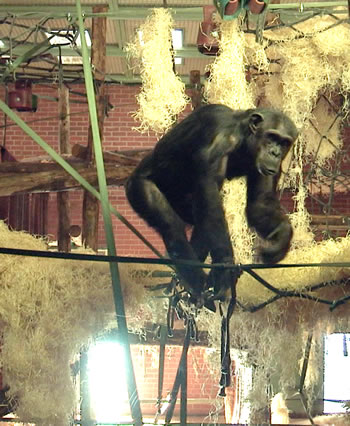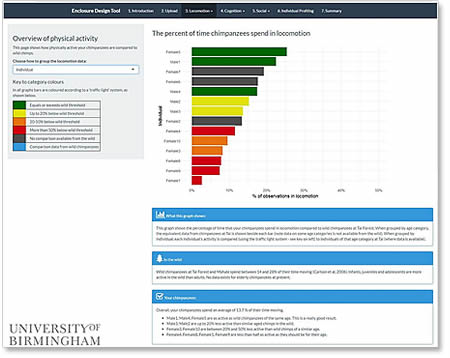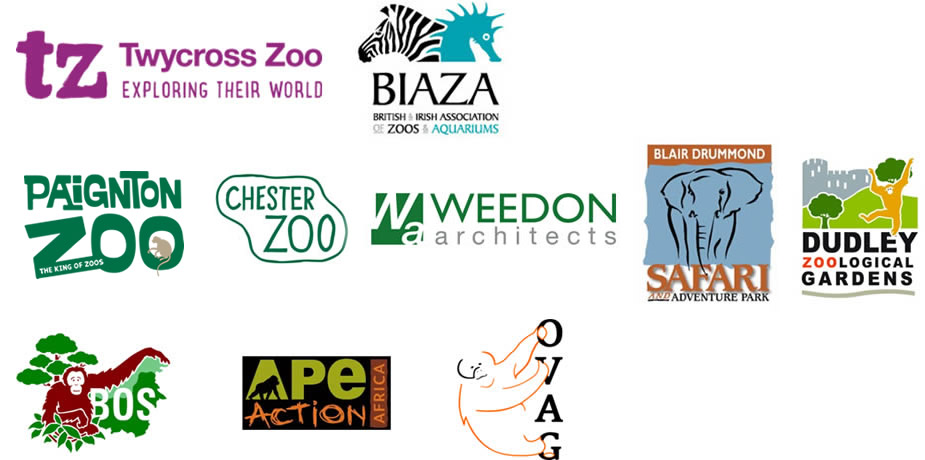Enclosure Design Tool
The Enclosure Design Tool (EDT)
The EDT is an interactive, computer interface that gives zoos and sanctuaries the ability to compare the behaviour of their chimpanzees and orangutans to the latest research on wild populations. It helps them use that information to create physically and mentally stimulating enclosures that mimic the physical and mechanical challenges wild great apes face in the forest canopy.
The International Union for Conservation of Nature (IUCN) has predicted that all non-human great apes (chimpanzees, orangutans, gorillas and bonobos) could be extinct in the wild within a human generation. The ability of sanctuaries to reintroduce great apes back into the wild, and of zoos to conserve the species while meeting their welfare needs, relies on encouraging the apes to exhibit the behaviours that are a vital part of the species’ ability to survive in the natural environment. Our focus on replicating the mechanical challenges of forest life is designed to directly address this problem.
The results so far are excellent; for example the EDT has substantially increased the level of arboreal locomotion in chimps at our Partner Twycross Zoo and has instigated key wildtype behaviours that had been absent. The EDT has tremendous promise to improve the lives of captive great apes and to help prepare those rescued by sanctuaries for life back in the wild.

A chimpanzee at Twycross explores its enclosure after modifications guided by the EDT
Photo: James McDonald
How does it work?
Zoos and sanctuaries collect data on the locomotion, cognition and social behaviour of their chimps or orangutans with user-friendly protocols that we have developed. They upload the data to the EDT, which automatically compares it to profiles we have generated for wild individuals. The EDT makes recommendations for how to modify the enclosures to elicit missing or under-represented wild-type behaviours. A further dataset is collected after the modifications are made, and the EDT quantifies whether the changes to the enclosure have been successful.

A screenshot of the EDT
Who did we work with to create it?
Close partnerships with zoos and sanctuaries have been central to the success of the EDT. We developed the zoo chimp EDT in partnership with Twycross Zoo and The British and Irish Association of Zoos and Aquariums (BIAZA), strongly supported by Chester Zoo, Paignton Zoo and Wheedon Architects, who sat on our Advisory Board.
Blair Drummond Zoo, Chester Zoo and Dudley Zoo are currently piloting the EDT to ensure it is applicable to a wide range of zoo environments.
We are currently working closely with the Bornean Orangutan Survival Foundation to develop the sanctuary orangutan EDT at the Samboja Lestari Orangutan Rehabilitation Centre in Borneo, with fantastic guidance from the Orangutan Veterinary Advisory Group. Ape Action Africa will be our partners after Christmas to help us develop an EDT for chimpanzees at the Mefou Primate Sanctuary in Cameroon.
NERC, The ARCUS Foundation, the PSGB and the University of Birmingham have kindly provided financial support for this project.
Parrot EDT
Motivated by the success of the EDT with great apes, the team are now working on an extension for another very popular group of animals: Parrots.
Why parrots? Parrots, of the diverse and colourful avian order Psittaciformes, are very popular in human care, both in zoological collections and as pets. The situation in the wild, however, is far less colourful, as human activities such as habitat fragmentation, the illegal pet trade and the introduction of non-native predators are having a big impact on the wild populations. It is estimated that over a quarter of all parrot species are threatened with extinction, and that many of the species that are not yet classified as threatened are suffering worrying population declines. Even though captive breeding and reintroduction programmes are an important conservation strategy, long-term captivity may lead to loss of wild behaviours and changes in body morphology, which will increase the challenge of reintroducing any future generations of captive-bred animals. Also, parrots are known for their advanced cognitive abilities, which, in captivity, may result in boredom, stress and frustration (often leading to poor welfare) when housed in environments that lack the right complexity and stimulation.
Starting with three species, scarlet macaw (Ara macao), African grey parrot (Psittacus erithacus) and swift parrot (Lathamus discolor), the parrot EDT will follow the same steps as for the great apes: assessing current behavioural repertoires, modifying enclosures to address missing behaviours and evaluating whether the modifications worked. This will help maintaining a wild-type repertoire of behaviours in captive parrots, both in short-term (e.g. rehabilitation and release programmes) and long-term captivity (e.g. zoo breeding programmes).
Reports, media coverage and Promotional material
The video below explains the collaboration with the University of Birmingham and Twycross Zoo
Monkey Business with Twycross Zoo
People involved and further information
Dr Susannah Thorpe (Principal Investigator) - email: s.k.thorpe@bham.ac.uk
Dr Jackie Chappell (Principal Investigator) - email: j.m.chappell@bham.ac.uk
Johanna Neufuss (Post Doc)
Nadine Sugianto (Post Doc)
Siska Sulistyo (Research Officer)
David Pettifer (PhD Student)
Jamie Dolling (PhD Student)
Ricardo Lemos De Figueiredo (PhD student)
Lelia Bridgeland Stephens (PhD student)
Ricko Jaya (PhD Student)
Charlotte King (PhD Student)
